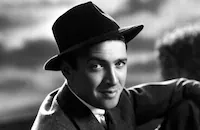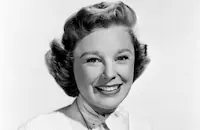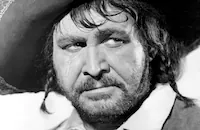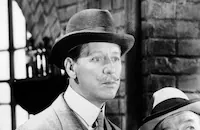The Glenn Miller Story

Brief Synopsis
Cast & Crew
Anthony Mann
James Stewart
June Allyson
Henry Morgan
Charles Drake
George Tobias
Film Details
Technical Specs

Synopsis
In East Los Angeles in the 1920s, Alton Glenn Miller fends off poverty by repeatedly hocking his trombone from pawnshop owner W. Kranz and then buying it back when he earns a little money. While attending yet another musician-for-hire job with his best friend, pianist Chummy MacGregor, Glenn is thrown out yet again for playing his jazzy arrangements. Soon after, Kranz informs them that Ben Pollack is holding tryouts for his band the next week. Hoping to sell his arrangements, Glenn leaves his trombone and brings only his work to Ben, who spurns them. After Chummy slips them to an auditioning musician, however, Ben hires Glenn immediately. With his advance, Glenn buys faux pearls for his college sweetheart, Helen Burger, but when the band tours near her Denver, Colorado home a few weeks later, Helen, who has not heard from Glenn in two years, barely remembers him. Undaunted, Glenn insists that she meet him after his job that evening, but by midnight, Glenn has not appeared and a furious Helen goes to sleep. Three hours later, Glenn wakes her outside her window, quickly charming her into driving to his parents' house nearby. At the Millers', Helen is surprised to discover that the whole family considers her Glenn's girl friend. They then visit their alma mater, the University of Colorado, where, to Glenn's chagrin, Helen admits that her favorite song is "Little Brown Jug." Although Helen begins to fall for his sincerity and passion for creating a new style of music, Glenn races off to join Chummy, promising only to call from the road. Two years later, Ben's band is gaining in popularity and moving from New York to Atlantic City, but Glenn remains behind, hoping to work on his arrangements with the help of band booker Don Haynes. Soon, Glenn is back to pawning his trombone, and accepts an offer to play in an orchestra for a musical play. One night, upon hearing "Little Brown Jug," Glenn calls Helen and asks her to come to New York that night to get married. Although she responds that she is engaged to another man, Glenn, ignoring her protests, urges her to call the number Pennsylvania 6-5000 when she arrives. Helen is at first disdainful, but, drawn to Glenn, soon finds herself on a train to New York. There, Glenn sweeps her over to their impromptu wedding service, and that night after Glenn's show, the couple return to their honeymoon suite to discover that the boys in the band have arranged a night out at Connie's Inn in Harlem. At the club, Glenn joins jazz greats such as Louis Armstrong and Gene Krupa onstage, finally carrying Helen over the threshold around dawn. Months later, Glenn is working steadily as a musician, but Helen prompts him to return to his dream of arranging. With her encouragement, he begins studying new compositions and writes "Moonlight Serenade." They are dismayed, however, when the song is converted into a nightclub number, and Helen convinces Glenn that he should form his own band. He, Chummy and Don put together a budget that seems unattainable, but Helen calmly reveals that she has been saving for the "Glenn Miller Band Fund" for years. Six months later, the band is barely breaking even, and Glenn despairs that he may never find the special sound for which he is searching. When their truck breaks just before a job at Boston's State Ballroom, Glenn stays behind, and later discovers that it has been cancelled and Helen is in the hospital, having collapsed from an exhaustion-induced miscarriage. Although the doctor declares that Helen can no longer bear children, Glenn promises that they will have a boy and a girl. The next day, State Ballroom owner Si Schribman visits Helen and, sorry for having cancelled the band, agrees to book them for an upcoming date. Glenn insists upon hiring a large band, and with Si's backing, tries out new arrangements. The night before they open, the trumpeter cuts his lip, and when Glenn replaces him with the clarinetist on "Moonlight Serenade," he finally achieves his unique sound, and a standing ovation. Over the next years, Glenn's sound sweeps the country, propelling his records to the top of the charts and providing Glenn, Helen and their adopted son Stevie with a luxuriant life style. On the couple's tenth anniversary, Glenn and Helen each plan a surprise for the other: Helen introduces Glenn to his new adopted daughter, and he throws her a party at which he plays his new song, "Pennsylvania 6-5000," and presents her with a small brown jug as a gift. Later, as Glenn scores a Hollywood film, Helen delivers the War Office letter which designates Glenn as an Army captain, and supports his decision to travel overseas to play for the troops. At first, Glenn is forced to lead the Army band in dull marching tunes, but when he spices up the marches, an impressed Gen. Arnold promotes him to bandleader. Assigned to London, Glenn bids his family a tearful goodbye at the airport, promising to "be right back." Overseas, the soldiers cheer as Glenn bravely leads the band amid air raids and falling bombs. While the war rages, through the invasion of France, D-day and the Allied liberation of Paris, Glenn writes to Helen about his postwar plans, and urges her to listen to his Christmas broadcast from Paris. On 15 Dec. 1944, he boards the flight from London to Paris, but the plane never lands. Just before Christmas, Helen receives the news that Glenn has disappeared, and, though devastated, listens to the Parisian broadcast with the children, Chummy and Si. When she hears Glenn's band playing his newest jazz arrangement of "Little Brown Jug," Helen realizes that Glenn's music and legacy will remain long after his death.

Director

Anthony Mann
Cast

James Stewart

June Allyson

Henry Morgan

Charles Drake

George Tobias

Barton Maclane

Sig Ruman

Irving Bacon
James Bell
Kathleen Lockhart
Katharine Warren

Frances Langford

Louis Armstrong
Ben Pollack
Gene Krupa
The Modernaires
The Archie Savage Dancers
Barney Bigard
James Young
Marty Napoleon
Arvell Shaw
Cozy Cole
Babe Russin
Dayton Lummis
Marion Ross

Phil Harris
Deborah Sydes
Ruth Hampton
Damian O'flynn
Carleton Young
William Challee
Steve Pendleton
Harry Harvey Sr.
Leo Mostovoy
Dick Ryan
Hal K. Dawson
The Mello-men
The Rolling Robinsons
Robert A. Davis

Lisa Gaye
Cicily Carter
Nino Tempo
Carl Vernell
John W. Grant
Ralph Brooks
Bonnie Eddy
Anthony Sydes
Roland Jones
Thomas Martin
Monte O'grady
Norman Stevens
Donald Clark
Foster Phinney
Kevin Cochran
Grace Richey
Donald Mcclelland
Crew
William Anderson
Harold Arlen
E. E. Bagley
Bob Bratton
Oscar Brodney
Leslie I. Carey
Julian Dash
Valentine Davies
Eddie De Lange
Edward Dodds
Buddy Feyne
Bill Finegan
William Fritzsche
Joseph Garland
Russell A. Gausman
Joseph Gershenson
George Gershwin
Ira Gershwin
Alexander Golitzen
Mack Gordon
Jerry Gray
W. C. Handy
Erskin Hawkins
Don Haynes
Julia Heron
Bernard Herzbrun
William Johnson
Joe Lapis
Chummy Macgregor
Henry Mancini
Henry Mancini
F. W. Meacham
Glenn Miller
Jay Morley Jr.
Mitchell Parish
Andy Razaf
Aaron Rosenberg
Russell Schoengarth
John Sherwood
Carl Sigman
Joan St. Oegger
Harry Warren
Bud Westmore
Kenny Williams
Spencer Williams
Joseph E. Winner
Joe Yukl

Photo Collections
Videos
Movie Clip




Trailer
Film Details
Technical Specs

Award Wins
Best Sound
Award Nominations
Best Score
Best Story and Screenplay
Articles
The Glenn Miller Story
In some ways, it wasn't surprising to see Hollywood lionize this popular musician who had appeared as himself in two of the better swing films of the forties, Orchestra Wives (1942) and Sun Valley Serenade (1941). So it was only fitting that one of tinsel town's most likable stars - James Stewart - play the famous bandleader. The actor's performance was a major factor in the film's success and Stewart truly fit the character to a tee, conveying the humble personality, wit, and charm of the trombone player turned composer. His teaming with June Allyson was also an inspired choice in portraying this real-life marriage as the perfect fairy tale romance. During their three films together (the other two films were Strategic Air Command (1955) and The Stratton Story(1949), Allyson and Stewart epitomized the ideal American couple and studio publicists were happy to build their promotional campaigns around these wholesome symbols of domestic bliss.
In preparing for the role, Stewart already knew how to play the piano from lessons in childhood, which proved useful in conveying Miller's creative process and personal style. As for the actor's trombone playing, he was dubbed by the musician Joe Yukl. At first, Stewart insisted on playing the trombone himself because he didn't want to look like he was faking it. However, it soon became apparent that he was woefully inadequate for the task so he agreed to plug up his mouthpiece and concentrate on learning the correct hand positions on the instrument. In Jimmy Stewart: A Wonderful Life by Jonathan Coe, the actor said he and Yukl "worked out the tunes I had to play with a series of photographs and with the musician showing me the position of the slide, and how long it stayed there. He'd stand to one side of the camera. The music was up above the camera. I'd watch the position of his trombone and match it.'
All the hard work paid off, however, because Stewart took home a handsome paycheck in the end, thanks to a signed guarantee with the studio for a percentage of the box office grosses. The Glenn Miller Story was ranked fifth for the year in profits, and the actor made over a million dollars from the arrangement with Universal with this film alone.
Director Anthony Mann was at the peak of his collaboration with Stewart; The Glenn Miller Story was their fourth film. Their creative partnership had begun in 1950 at Universal Pictures with Winchester '73 and would continue with Thunder Bay (1953), a drama concerning a clash between fishermen and oilmen, The Glenn Miller Story, and an excellent western, The Far Country(1954). But only The Glenn Miller Story met the studio's financial expectations. Oddly enough, the biopic was considered a risky venture at the time because other musical biographies like The Fabulous Dorseys (1947) had proved to be box office bombs and besides, Glenn Miller had been out of the news since his disappearance ten years before. It's also true that Mann never cared much for the film (he took on the job as a favor to Stewart), stating that it was terribly theatrical, focused too much on the musical numbers, and lacked any real drama or story. Audiences felt otherwise and joined June Allyson in a good cry at the film's bittersweet climax where she breaks down while listening to Miller's rendition of her favorite song, "Little Brown Jug."
A perfect example of Universal's A product, The Glenn Miller Story is full of memorable moments such as the scene in which Miller is finally inspired to create his signature, up-front clarinet sound for "Moonlight Serenade." Mann develops and executes this sequence with both understated beauty and a love for the composer and the music. The director's collaboration with the great cinematographer William Daniels employs a visual color arc that goes from drabness (Miller's early struggles) to the heavenly colors of artistic and commercial success and marital bliss. Daniels' gifts are particularly apparent in the sequence set in the Harlem nightspot, Connie's Inn, where his evocative use of color also has thematic relevance. Perhaps the only faults The Glenn Miller Story can be cited for are the obvious liberties that were taken with the band leader's career and a tendency to become overly sentimental at times. But since the movie alternately swings and serenades its audience so expertly, does it really matter?
Music buffs will particularly appreciate The Glenn Miller Story because it is loaded with several musical contemporaries of Glenn Miller: the great drummer Gene Krupa, Ben Pollack, Louis Armstrong, Frances Langford, and the group The Modernaires. And of course, there is all that great music - "String of Pearls," "Pennsylvania 6-5000," "Tuxedo Junction," "In the Mood," and "Basin Street Blues" to name just a few. Miller's personal friend, Chummy MacGregor (played in the film by Harry Morgan, a future regular on TV's M*A*S*H*), served as technical advisor on the movie and Henry Mancini handled the musical arrangements. The Glenn Miller Story was nominated for an Academy Award for Best Score, but lost to Adolph Deutsch and Saul Chaplin for Seven Brides for Seven Brothers(1954).
Producer: Aaron Rosenberg
Director: Anthony Mann
Screenplay: Valentine Davies and Oscar Brodney
Cinematography: William H. Daniels
Costume Design: Jay A. Morley Jr.
Film Editing: Russell F. Schoengarth
Original Music: Glenn Miller (uncredited)
Principal Cast: James Stewart (Glenn Miller), June Allyson (Helen Berger), Harry Morgan (Chummy (as Henry Morgan)), Charles Drake (Don Haynes), George Tobias (Si Schribman).
C-113m. Closed captioning.
by Richard Steiner

The Glenn Miller Story
Quotes
Trivia
Notes
The closing credits include the following written statement: "We gratefully acknowledge the cooperation of the Armed Forces of the United States of America." As portrayed in the film, Glenn Miller (1904-1944) rose to fame first as a trombonist and then as a big band leader in the 1930s and 1940s. On 15 Dec. 1944, he disappeared while on a military flight from London to Paris. For more information on Miller's life and career, see the entry for Orchestra Wives in the AFI Catalog of Feature Films, 1941-50.
After Universal-International bought the rights to Miller's life story from his widow, Mrs. Helen Miller, an August 1952 Los Angeles Examiner article stated that Tyrone Power and Gregory Peck were being considered to star in the film. A July 1953 Hollywood Reporter "Rambling Reporter" column reported that Dinah Shore had been offered the role of "Helen Burger" but refused it. According to studio press information, Mrs. Miller personally approved the casting of James Stewart and lent him her husband's glasses and trombone to use in the film. Press materials identify the following Colorado locations used in the film: University of Colorado, Boulder; Denver Civic Center; Lowry Air Force Base and the Elitch Gardens Ballroom. Although Babe Russin is the only Glenn Miller Orchestra member to appear in the film, a May 1953 Daily Variety news item states that original band members Chummy MacGregor, Hal McIntyre, Willie Schwartz, Dick Fisher, Paul Tanner, Zeke Zarchy, Conrad Gozzo and Rolly Bundock contributed to the film's score. Hollywood Reporter news items add Britt Wood to the cast and, in her feature film debut, Jimmy Dorsey's daughter Julie, but their appearance in the final film has not been confirmed. Lisa Gaye and Cicily Carter made their feature film debuts in The Glenn Miller Story. The film also marked the final screen appearance of Frances Langford (1914-2005), who appeared as herself. Langford, a well-known singer and radio star of the 1930s and 1940s, became one of the most popular performers to entertain combat troops during World War II, most often accompanying Bob Hope on his USO tours.
The film received rave reviews, with the Daily Variety review faulting it only for the absence of singer-band leader Tex Beneke, "who gained band fame with Miller and led the outfit for several years after the maestro's death." The Glenn Miller Story received Academy Award nominations for Best Music (Scoring Musical Picture) and Best Writing (Story and Screenplay). Leslie I. Carey won the Oscar for Best Sound Recording.
The Daily Variety review noted that after the picture's release, RCA-Victor, which released Miller's recording during his lifetime, produced a tie-in album of Miller's greatest hits, even though Universal typically marketed promotional albums through Decca Records. According to an October 1954 Variety item, Mrs. Miller sued Universal over the soundtrack release, claiming that she sold only the film production rights to Miller's music. The disposition of this suit is not known. According to a December 1961 Los Angeles Mirror story Mrs. Miller, who received a percentage of the film's profits, sued the studio again in an attempt to obtain a full accounting of the profits, but her suit was rejected by the New York Supreme Court. An August 1952 Hollywood Reporter news item announced that Miller's friend, Edward Kirby, was to act as the advisor on the film. Kirby is not listed in the onscreen credits, and sued Universal for $250,000 in 1954 for breach of contract. A June 1954 Daily Variety article stated that Kirby claimed to have originated the idea for the picture and signed over rights for $3,000 after being told that he would be compensated later. In June 1956, Daily Variety reported that the suit was settled out of court for an undisclosed sum.
Universal re-released The Glenn Miller Story in 1960 and again in 1985 for the Cannes Film Festival's "Homage to James Stewart." For the Cannes release, the picture was updated with a Dolby stereo soundtrack. According to modern sources, as part of the film's publicity campaign, a time capsule was buried underneath the Miami Beach, FL Carib Theatre, containing the screenplay, Mrs. Miller's pearls, and a nightclub menu. Although the theater was subsequently torn down, the capsule was discovered on December 26, 1996, when construction workers were building a new structure.

Miscellaneous Notes
Released in United States Winter February 1954
Released in USA on laserdisc December 1988.
Released in United States Winter February 1954














